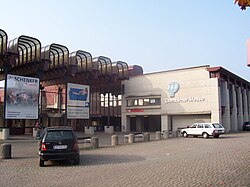Dornbirn fair
| Messe Dornbirn GmbH
|
|
|---|---|
| legal form | GmbH |
| founding | 1949 |
| Seat | Dornbirn, Austria |
| management | Sabine Tichy-Treimel |
| Branch | service |
| Website | www.messedornbirn.at |
The fair Dornbirn GmbH operates the exhibition center in Dornbirn and is the largest exhibition organizer in Vorarlberg .
history
On the initiative of the Dornbirn Tourist Association under the direction of Sparkasse Director Eugen Lecher , the “1. Dornbirn Export and Model Show ”. The aim was to promote the export of Vorarlberg products, especially products from the then large textile industry. Hermann Rhomberg acted as exhibition director .
At that time the exhibition took place in the premises of the various schools in the center of Dornbirn as well as in tent halls. Since the first exhibition was a complete success with 541 exhibitors (including 509 from Austria) and 150,000 visitors, it was decided to repeat the exhibition in the following years and to set up a separate company, the "Export- und Mustermesse Ges.mbH Dornbirn" establish.
Although the re-establishment of the Dornbirner Messe after the Second World War brought an economic upswing for the city and the country, more and more criticism of the personnel structures of this time is being voiced today. According to the allegations, the founders of the new Dornbirn trade fair are said to have been exclusively wealthy factory owners. They would have cooperated with the National Socialists and would have escaped denazification after the end of the war through their participation in the Dornbirn fair . Although many Dornbirn factory owners were National Socialists, the correctness of this statement can no longer be fully understood today. After the war, the former NS governor Anton Plankensteiner, as well as press chief of Hohenems Nazi propagandist and anti-Semitic publicist Bruno Amann (1913–1963) and secretary, Natalie Beer (1903–1987 ), the former regional department head of the NS women’s society, also attended the Dornbirner Messe after the war ) employed.
In 1953, the exhibition hall, today's town hall, was built at the school center, which, in addition to its function as an exhibition hall, could also be used as an event hall during the year. In 1957, a symbol of the economic upswing was built with the “Messehochhaus” in Realschulstrasse.
In 1966, the textile sector was spun off from the summer fair and relocated to its own trade fair in autumn. However, this was unsuccessful and this trade fair was closed again two years later. The summer fair (today the autumn fair) remained as a non-specialist trade fair.
The exhibition space in the schools soon no longer met the requirements. This is how today's exhibition center was built on the outskirts of the city at the Dornbirn-Süd motorway exit. In 1975 the first fair was held in the new area.
In 1976 the name of the fair was changed to "Dornbirner Messe". The new area now made it possible to hold trade fairs during the school year, and so the “Hobby and Leisure Fair” (today the spring fair) was reinstalled in the spring.
Because the traditional trade fair date at the end of July / beginning of August was the most popular holiday season and in some cases very hot trade fair weeks led to a decline in visitors, it was decided in 1995 to hold the main trade fair in the first week of September. The fair has been run as an "autumn fair" since then.
Around the turn of the millennium, further trade fairs were added to the program in Dornbirn in addition to the spring and autumn trade fairs. Today the church fair “Gloria”, the art fair “art bodensee” that takes place during the festival season, the occupational safety fair “Preventa” and the technology fair “intertech”, which took place alternately in St. Gallen and Dornbirn, belong to the Dornbirn fair family. Since 2010 the "intertech" has only taken place in Dornbirn.
In 2005 the autumn fair was shortened from the traditional nine to five days (Wednesday to Sunday) for the first time. In 2006, the new "Haus der Messe" (also called "Wirtschaftszelt") and the new administration office at the exhibition center were moved into. The product name was changed to "Messe Dornbirn". The company name remains "Dornbirner Messe GmbH".
2013 was first held in October as "Die Gustav". As an international salon for consumer culture, exhibitors from the areas of design and enjoyment present themselves here.
Messe Dornbirn GmbH
people
- Management: Sabine Tichy-Treimel
- Head of Finances & Human Resources: Martin Geipel
- Head of Technology & Infrastructure: Stefan Rippl
measure up
- Autumn fair
- com: construction
- Look!
- Gloria (in cooperation with Messe Augsburg, ibid)
- Intertech
- art lake constance
- Wedding & Event
- Baby Child
- The Gustav
Location
The Dornbirn exhibition center is located directly at exit 18 of the Rheintal / Walgau motorway (A14). The administration is located in the new building of the fair at Messeplatz.
Exhibition stadium
The exhibition stadium is a multi-purpose ice hall on the grounds of the Dornbirn exhibition center.
Individual evidence
- ↑ Gustav - Time and Space for Good Taste ( Memento from August 21, 2014 in the Internet Archive )
- ^ The Gustav - organizer page
Web links
Coordinates: 47 ° 24 ′ 33.9 " N , 9 ° 42 ′ 38.4" E



